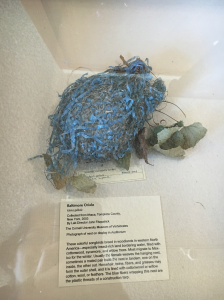When I heard about Cornell’s Lab of Ornithology, my first thought was a zoo-like habitat with different birds that visitors could look at. I was wrong, but in a good way. I didn’t know that Cornell had a Lab of Ornithology to begin with, and I didn’t know how much it had to offer. We started the trip going on a walking tour of the grounds around the building. I felt sort of bad crashing a very small group, as it was hard to hear the tour guides, both Cornell students, with the fairly large group of people trying to walk their trails.
This also made it hard to identify the birds that they tried to point out, because either they were behind a tree from where I was standing, or they had flown away before I had a chance to try looking. The trails were really nice for walking though, and I imagine they would be even lovelier when it’s warmer outside and the trees aren’t bare. After the walking tour, we had several minutes to look at the pond area from inside the building, and it was surprisingly relaxing.
Then, we followed the tour guides on a look behind the scenes, which was unexpectedly large. They started off explaining the rationale behind the large murals on the wall. The large scale of both of them was amazing, and I was disappointed that we weren’t able to go upstairs to get a better view of them. We were then taken into the Fuertes study which had paintings of birds which were created as a present for the owner’s wife. There was also a gallery display of close-up bird nest photographs. Sadly, we didn’t get a chance to stay and look at them in more detail, but they were really interesting to look at.
We were taken to the research area of the lab which included specimen preparation and genomic studies of ancient DNA. I had also learned certain classes at Cornell will make use of the classroom there to look more closely at certain specimens. The Lab of Ornithology didn’t only have birds, but they actually look at lots of different specimens. Not only do they have a herpetological collection, but when they introduced using sounds to study environmental changes, they mentioned collecting data at sea and right whales.
We ended with a look into their library, which housed some early sound recording devices used by researchers, as well as the field notebooks certain prominent bird watchers used. I was surprised at how much the Lab or Ornithology had to offer, and would definitely like to go back when the weather is warmer to spend some more time on their trails and looking more closely at the paintings and photographs that they have on display. Since admission is free, I’d definitely recommend going to visit it at least once.




